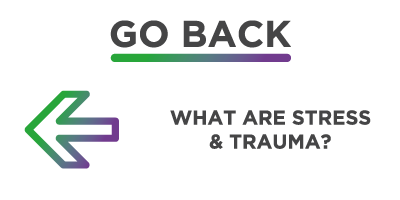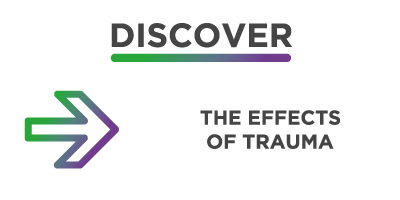Past trauma activates the right hemisphere of the brain and deactivates the left. The two halves of our brain are different: the right is intuitive, emotional, spatial, and tactile, and the left is linguistic, sequential, and analytical. While the left half of the brain does all the talking, the right half communicates through facial expressions and body language and by singing, swearing, crying, dancing or mimicking.
The right brain is the first to develop in the womb, and it carries the nonverbal communication between mothers and infants. We know the left hemisphere has come online when children start to understand language and learn how to speak. This enables them to name things, compare them and begin to communicate their own experiences to others. The left brain remembers facts, statistics, and the vocabulary of events. We use it to explain and order our experiences. The right brain stores memories of sound, touch and smell, and the emotions they evoke. It reacts automatically to voices, faces, gestures and places.
Deactivation of the left hemisphere has a direct impact on our capacity to organise experience into logical sequences and to translate our shifting feelings into words. Without sequencing, we can’t grasp the long-term effects of our actions or plan. When something reminds traumatised people of the past, their right brain reacts as if the traumatic event were happening in the present. Because their left brain is deactivated, they may not be aware that they are re-experiencing the past, they just feel furious, terrified or frozen.
As well as two different hemispheres our brains also have three distinct layers. Our rational brain (the neocortex) is the evolutionarily youngest part and is primarily concerned with the world outside us: understanding how things and people work, deciding how to accomplish goals and manage time. Beneath the rational brain lies two older, and to some degree separate brains: the reptilian brain (brain stem and cerebellum) and the emotional brain (the limbic system, including the amygdala and hippocampus). These oversee the management of our body’s physiology and identify comfort, safety, threat, hunger, fatigue, desire, longing, excitement, pleasure and pain.
The brain develops level by level within every child in the womb. The most primitive part, the reptilian brain, is already online when we are born and is responsible for all the things that new-born babies can do: eat, sleep, wake, cry, breathe; feel temperature, hunger, wetness, and pain; rid the body of toxins by urinating and defecating; coordinate the heart and lungs and the endocrine and immune systems. Wrapped around the reptilian brain is the emotional brain. Development of this part of the brain mainly happens after a baby is born. It is the monitor of danger, the judge of what is pleasurable or scary or important for survival. It develops in response to experience, in partnership with the infant’s own genetic makeup and inborn temperament. Whatever happens to a baby contributes to the emotional and perceptual map of the world that its developing brain creates: if you feel safe and loved, your brain becomes specialised in exploration, play, and cooperation; if you are frightened and feel unwanted, it specialises in managing feelings of fear and abandonment. These structures can be significantly modified by later experiences, for the better, or for the worse.
The emotional brain is at the heart of the central nervous system. Its key task is to look out for our welfare and if it detects danger or a special opportunity it alerts us by releasing a squirt of hormones. The resulting bodily sensations (ranging from mild queasiness to the grip of panic) will interfere with whatever our mind is currently focused on and get us moving. Even at their most subtle, these sensations have a significant influence on the small and large decisions we make throughout our lives: what we choose to eat, where we like to sleep, what music we prefer, whether we like to play golf or sing, who we befriend and who we dislike. The emotional brain assesses information in a global way and jumps to conclusions based on rough similarities. It initiates pre-programed escape plans: fight-or-flight. These muscular and physiological reactions are automatic, set in motion without any thought or planning on our part.
Wrapped around the emotional brain is the rational brain. We share this outer layer with other mammals, but it’s much thicker in us humans. In the second year of life, the frontal lobes (which make up the bulk of our rational brain) begin to develop at a rapid pace. They are responsible for the qualities that make us unique within the animal kingdom: using language and abstract thought; absorbing and integrating information and attaching meaning to it, and planning and reflecting. They make choice possible, underlie our creativity, and also empathy (our ability to “see” situations through another’s eyes and “feel” what it’s like to be them).
Mirror neurons in our rational brain facilitate empathy, imitation and synchrony. They also make us vulnerable to others’ negativity, so that we may respond to their anger with fury or get dragged down by their depression. Trauma invariably involves not being seen, not being mirrored and not being considered. Treatment needs to reactivate the capacity to safely mirror, and be mirrored, but also to resist being hijacked by others’ negative emotions: well-functioning frontal lobes are crucial for harmonious relationships. Without flexible, active frontal lobes we become creatures of habit, our relationships superficial and routine, lacking innovation, discovery and wonder. Our frontal lobes can also sometimes stop us from doing things that will embarrass us or hurt others, but the more intense the deep inward feelings from the emotional brain, the less capacity the rational brain has to diffuse them.
Danger is a normal part of life: our brains detect it and organise our responses. Sensory information about the world arrives through our eyes, nose, ears and skin. These sensations converge in the thalamus (in the emotional brain). The thalamus combines all the input from our perceptions into an integrated experience of “what is happening to me”. The sensations are then passed on in two directions: down to the amygdala and up to the frontal lobes. The pathway to the amygdala is extremely fast, and the one to the rational brain takes several milliseconds longer during an overwhelmingly threatening experience.
The central function of the amygdala is to identify whether incoming input is relevant to our survival. It does so quickly and automatically, with the help of the hippocampus (which compares the new input to past experiences). If the amygdala senses a threat it sends an instant message down to the hypothalamus (also in the emotional brain, below the thalamus) and the brain stem, activating the stress-hormone system and the autonomic nervous system (ANS) to mobilise a whole-body response. Because the amygdala processes the information it receives from the thalamus faster than the frontal lobes do, it decides whether incoming information is a threat to our survival even before we are consciously aware of the danger. By the time we realise what is happening, our body may already be on the move.
Stress hormones increase heart rate, blood pressure and rate of breathing, preparing us to fight or run away. Once the danger has passed, the body returns to its normal state quickly. But when recovery is blocked, the body is triggered to continue to defend itself, which makes people feel agitated and aroused. The amygdala is usually pretty good at picking up danger clues, but trauma increases the risk of misinterpreting whether a situation is dangerous or safe. If you’re not too upset, your frontal lobes can restore your balance by helping you realise that you’re responding to a false alarm and abort the stress response. If you’re very upset the amygdala just gets you ready to fight or run away, even before the frontal lobes get a chance to make their assessment.
There is another possible response to danger. Some people go into denial: their bodies register the threat, but they go on as if nothing has happened. However, even though the mind may learn to ignore the messages from the emotional brain the alarm signals don’t stop. The emotional brain keeps working, and stress hormones keep sending signals to the muscles to tense for action or immobilise in collapse. The physical effects on the organs go on until they are expressed as illness or difficulties with sleep, appetite, touch, digestion, attention, memory or arousal. They also contribute to many long-term physical health issues. Any effective treatment for trauma must address these basic housekeeping functions of the body.
The medial prefrontal cortex (MPFC, part of the frontal lobes, directly above our eyes) can enable us to observe what is going on, predict what will happen if we take a certain action, and make a conscious choice. Taking time to respond allows our rational brain to restrain and organise the automatic reactions of the emotional brain which is important for preserving our relationships. If our frontal lobes are working properly, we’re not likely to lose our temper easily and can realise that other people’s anger and threats are a caused by their emotional state, but if not, we become like conditioned animals, automatically going into fight-or-flight mode the moment we detect danger.
I offer a free initial telephone conversation, giving you as much time and space as you need to consider whether you’d like to come and meet me.






